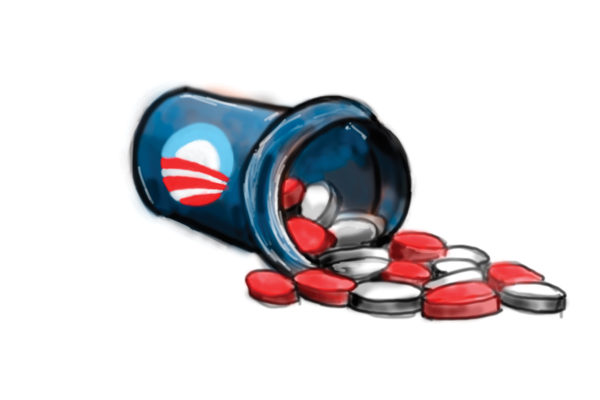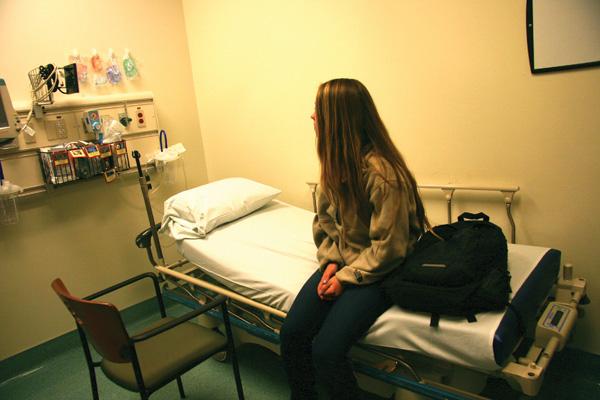
Emrich Stovel, a 2004 Palo Alto High School alum, has eleven scars, across the sides of his body from surgery that removed the top of his left lung. Two episodes of spontaneous pneumothorax (collapsed lung) in his senior year at Paly left Stovel in the hospital twice in two weeks after attempts to re-inflate his lung. After leaving Palo Alto to attend college in Oregon, his left lung collapsed again and then several more times in the following months. Finally, Stovel went through surgery to remove a small part of his lung.
Dealing with long hospital stays and surgery is not the only reason Stovel’s life is more difficult as a result of his condition; at the time of his lung collapse, Stovel was still under the age of 26, covered by his parents’ health care plan. There was no increase in rates before he reached this age, and his three surgeries were covered without complications. This was made possible by the early implentation of the Affordable Care Act’s 26 and under section.
Now, Stovel is 28 and has been unable to purchase insurance for two years. He was no longer able to stay on his parents’ plan after his 26th birthday and, because of his pre-existing condition, companies have rejected all of his applications for new insurance. In October, when the Affordable Care Act Marketplace opens, Stovel will join the over 15,000 Californians with pre-existing conditions who bought insurance after Sept 2013, whohave already gained coverage through the Pre-Existing Condition Insurance Plan, since the program began according to the U.S. department of Health & Human Services.
Stovel is one of the nearly 2.3 million uninsured Californians between the ages 18 and 35. On Oct 1, everything changes. The beginning of October marks the opening of California’s online health care Marketplace, Covered California, an interactive website that will allow around 5.6 million eligible California residents to compare comprehensive health insurance plans and choose one that best fits their needs. The health care benefits begin on Jan. 1, 2014.
“I am both hopeful and skeptical that the new laws and health care exchanges will bring costs down,” Stovel says. “If they did come down to the same ballpark as what I pay for car insurance, I would jump at it.”
Economists speculate whether young people like Stovel will actually enroll in health care, or pay the $95 penalty for failed compliance with the law instead. In 2015, that fee will jump to $315 and in 2016, $695.
The Affordable Care Act will impact young people and their relationship to health care. Today, thousands of children are unable to enroll in health care because of pre-existing conditions like asthma, diabetes, or the lung collapses Stovel dealt with, as insurance companies reject their applications, favoring lower-risk customers.
With the implementation of the law, insurance providers will no longer be able to charge more or deny coverage of conditions that millions of Californians have dealt with since birth.
In the past, health care companies have had the legal right to take people of their family’s health care plan as early as their eighteenth birthday. The Affordable Care Act allows young people to stay on their family’s health care plan until they turn 26. Children can join or remain on a plan even if they are married, not living with their parents, attending school, not financially dependant on their parents or eligible to enroll in their employer’s plan.
This part of the law went into effect for plans beginning Sept. 23. Those under 26 often referred to as “young healthies,” have traditionally been less likely to purchase health care because of lower incomes and lesser predicted need. Under the law, it will not only be easier for young people to gain coverage, but it will be mandated that they have some type of health insurance.
An alternative to the traditional health care plan, the Catastrophic Plan is available to people less than 30 years old and those with limited incomes. The catastrophic plan requires payment of most medical bills, under a specified amount, while still covering three primary care visits per year and cost-free preventative care. The monthly premiums and out of pocket costs for catastrophic plans is much lower than that of traditional comprehensive care. However, premiums and other costs are based on income. This alternative care option is ideal for “young healthies” as it provides only bare essential coverage for a more affordable price.
Insurance companies also have to provide preventative care free of additional cost, excepting grandfathered plans purchased before March 23, 2010. This includes contraception and a variety of women’s health screenings including those for cervical cancer and anemia. The preventive care section of the law applies to plans beginning after Sept. 23.
As with many bills introduced in Washington D.C.’s currently partisan political climate, the Affordable Care Act faces backlash. This backlash travelled across the country in 2009’s August Recess, when members of the Tea Party flooded town hall meetings to protest the legislation, after it passed in the Senate earlier that year. In 2010, the bill was passed and signed by President Obama.
However, the Obama Administration and the Democratic Party have yet to win the fight to implement the Affordable Care Act. The Republican house has voted 42 times to kill the Affordable Care Act legislation.
A budget bill passed the House in late September with no funding for implementation of the Affordable Care Act included. The bill is unlikely to pass the Democratically dominated Senate, and even less likely to be signed by President Obama. If the bill is passed and signed, the Affordable Care Act will receive no funding for implementation and be largely obsolete.
Disagreement over budget bills is common in D.C., and Congress often votes to temporarily to fund the budget until a bill is proposed on which both parties can agree on. However, major members of the Republican party have threatened to vote against a postponed budget vote, which would lead to a government shutdown.
In a shutdown, the government stops providing all but “essential” services. The United States has not experienced a shutdown since 1995.
On Sept 24, 2013 Republican Sen. Ted Cruz (R-TX) began his attempt to pseudo filibuster the Affordable Care Act vote in the Senate. No proceedings were in progress, and the Senate was largely empty at the time.
“We need to make DC listen,” Cruz said. “Make them listen to the single mom working in the diner, struggling to feed her kids who has just been told she has to take a cut in hours due to Obamacare.”
Stanford Professor Liran Einav, who teaches and writes about the economics of health insurance, says the problem with the old health care system was rising costs which led to a large swath of uninsured people. This in turn put pressure on the government health system, because uninsured people, with no other way to see a doctor, would go to hospital emergency room for treatment, clogging up Emergency Rooms and reducing the efficiency of urgent care facilities.
According to Einav the law will have the greatest effect on young people.
“Many [young people] are uninsured; if you look at the people that will be most affected, it’s the people who were previously uninsured,” Einav says. “Now they will have to be insured or pay a big fine. The biggest group that’s uninsured was young adults.”

Uninsured Americans are now faced with the with the dilemna of buying health insurance and complying with the law, or paying an often less expensive fine?
Daniel Bennet of The Atlantic Wire writes, “In order for the plan to work, we need some people (especially young, healthy people) to pay more into the health care exchanges than they receive in services for the risk pool math to work.”
Dan Gorenstein for Marketplace.org writes, “Estimates show a majority of the uninsured signed up for coverage within a year and a half of the law passing.” Some surveys claim that as many as 10 percent of Americans will pay the penalty over buying health insurance.
Einav does not like the general tone of the media surrounding the law.
“People want to read about next year’s check as opposed to the check we’re going to have to pay when we’re 55,” he says, “Someone needs to take a long term view and the government is doing it. It’s a general long term plan.”


